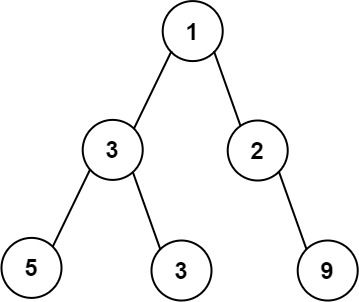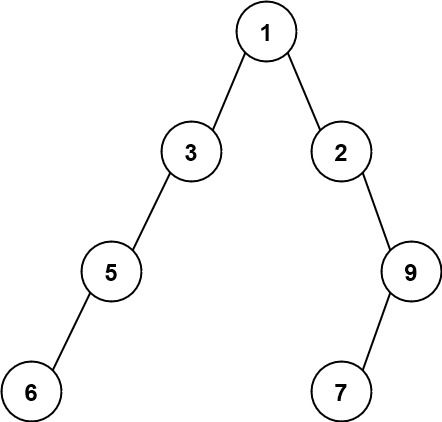树
深度优先搜索
广度优先搜索
二叉树
题目描述
给你一棵二叉树的根节点 root ,返回树的 最大宽度 。
树的 最大宽度 是所有层中最大的 宽度 。
每一层的 宽度 被定义为该层最左和最右的非空节点(即,两个端点)之间的长度。将这个二叉树视作与满二叉树结构相同,两端点间会出现一些延伸到这一层的 null 节点,这些 null 节点也计入长度。
题目数据保证答案将会在 32 位 带符号整数范围内。
示例 1:
输入: root = [1,3,2,5,3,null,9]
输出: 4
解释: 最大宽度出现在树的第 3 层,宽度为 4 (5,3,null,9) 。
示例 2:
输入: root = [1,3,2,5,null,null,9,6,null,7]
输出: 7
解释: 最大宽度出现在树的第 4 层,宽度为 7 (6,null,null,null,null,null,7) 。
示例 3:
输入: root = [1,3,2,5]
输出: 2
解释: 最大宽度出现在树的第 2 层,宽度为 2 (3,2) 。
提示:
树中节点的数目范围是 [1, 3000]
-100 <= Node.val <= 100
解法
方法一:BFS
对节点进行编号,初始根节点编号为 $1$。
对于一个编号为 i 的节点,它的左节点编号为 i<<1,右节点编号为 i<<1|1。
采用 BFS 进行层序遍历,求每层的宽度时,用该层的最大节点编号减去最小节点编号再加一即可。
时间复杂度 $O(n)$,空间复杂度 $O(n)$。其中 $n$ 是二叉树的节点数。
Python3 Java C++ Go
1
2
3
4
5
6
7
8
9
10
11
12
13
14
15
16
17
18
19 # Definition for a binary tree node.
# class TreeNode:
# def __init__(self, val=0, left=None, right=None):
# self.val = val
# self.left = left
# self.right = right
class Solution :
def widthOfBinaryTree ( self , root : Optional [ TreeNode ]) -> int :
ans = 0
q = deque ([( root , 1 )])
while q :
ans = max ( ans , q [ - 1 ][ 1 ] - q [ 0 ][ 1 ] + 1 )
for _ in range ( len ( q )):
root , i = q . popleft ()
if root . left :
q . append (( root . left , i << 1 ))
if root . right :
q . append (( root . right , i << 1 | 1 ))
return ans
1
2
3
4
5
6
7
8
9
10
11
12
13
14
15
16
17
18
19
20
21
22
23
24
25
26
27
28
29
30
31
32
33
34
35
36
37 /**
* Definition for a binary tree node.
* public class TreeNode {
* int val;
* TreeNode left;
* TreeNode right;
* TreeNode() {}
* TreeNode(int val) { this.val = val; }
* TreeNode(int val, TreeNode left, TreeNode right) {
* this.val = val;
* this.left = left;
* this.right = right;
* }
* }
*/
class Solution {
public int widthOfBinaryTree ( TreeNode root ) {
Deque < Pair < TreeNode , Integer >> q = new ArrayDeque <> ();
q . offer ( new Pair <> ( root , 1 ));
int ans = 0 ;
while ( ! q . isEmpty ()) {
ans = Math . max ( ans , q . peekLast (). getValue () - q . peekFirst (). getValue () + 1 );
for ( int n = q . size (); n > 0 ; -- n ) {
var p = q . pollFirst ();
root = p . getKey ();
int i = p . getValue ();
if ( root . left != null ) {
q . offer ( new Pair <> ( root . left , i << 1 ));
}
if ( root . right != null ) {
q . offer ( new Pair <> ( root . right , i << 1 | 1 ));
}
}
}
return ans ;
}
}
1
2
3
4
5
6
7
8
9
10
11
12
13
14
15
16
17
18
19
20
21
22
23
24
25
26
27
28
29
30
31
32 /**
* Definition for a binary tree node.
* struct TreeNode {
* int val;
* TreeNode *left;
* TreeNode *right;
* TreeNode() : val(0), left(nullptr), right(nullptr) {}
* TreeNode(int x) : val(x), left(nullptr), right(nullptr) {}
* TreeNode(int x, TreeNode *left, TreeNode *right) : val(x), left(left), right(right) {}
* };
*/
class Solution {
public :
int widthOfBinaryTree ( TreeNode * root ) {
queue < pair < TreeNode * , int >> q ;
q . push ({ root , 1 });
int ans = 0 ;
while ( ! q . empty ()) {
ans = max ( ans , q . back (). second - q . front (). second + 1 );
int i = q . front (). second ;
for ( int n = q . size (); n ; -- n ) {
auto p = q . front ();
q . pop ();
root = p . first ;
int j = p . second ;
if ( root -> left ) q . push ({ root -> left , ( j << 1 ) - ( i << 1 )});
if ( root -> right ) q . push ({ root -> right , ( j << 1 | 1 ) - ( i << 1 )});
}
}
return ans ;
}
};
1
2
3
4
5
6
7
8
9
10
11
12
13
14
15
16
17
18
19
20
21
22
23
24
25
26
27
28
29
30
31
32 /**
* Definition for a binary tree node.
* type TreeNode struct {
* Val int
* Left *TreeNode
* Right *TreeNode
* }
*/
func widthOfBinaryTree ( root * TreeNode ) int {
q := [] pair {{ root , 1 }}
ans := 0
for len ( q ) > 0 {
ans = max ( ans , q [ len ( q ) - 1 ]. i - q [ 0 ]. i + 1 )
for n := len ( q ); n > 0 ; n -- {
p := q [ 0 ]
q = q [ 1 :]
root = p . node
if root . Left != nil {
q = append ( q , pair { root . Left , p . i << 1 })
}
if root . Right != nil {
q = append ( q , pair { root . Right , p . i << 1 | 1 })
}
}
}
return ans
}
type pair struct {
node * TreeNode
i int
}
方法二:DFS
定义 dfs(root, depth, i) 表示从深度为 depth,且编号为 i 的节点 root 开始往下搜索。记录每一层最先访问到的节点的编号。访问到当前层其它节点时,求当前节点编号与当前层最小编号的差再加一,更新当前层的最大宽度。
时间复杂度 $O(n)$,空间复杂度 $O(n)$。其中 $n$ 是二叉树的节点数。
Python3 Java C++ Go
1
2
3
4
5
6
7
8
9
10
11
12
13
14
15
16
17
18
19
20
21
22
23 # Definition for a binary tree node.
# class TreeNode:
# def __init__(self, val=0, left=None, right=None):
# self.val = val
# self.left = left
# self.right = right
class Solution :
def widthOfBinaryTree ( self , root : Optional [ TreeNode ]) -> int :
def dfs ( root , depth , i ):
if root is None :
return
if len ( t ) == depth :
t . append ( i )
else :
nonlocal ans
ans = max ( ans , i - t [ depth ] + 1 )
dfs ( root . left , depth + 1 , i << 1 )
dfs ( root . right , depth + 1 , i << 1 | 1 )
ans = 1
t = []
dfs ( root , 0 , 1 )
return ans
1
2
3
4
5
6
7
8
9
10
11
12
13
14
15
16
17
18
19
20
21
22
23
24
25
26
27
28
29
30
31
32
33
34
35
36
37 /**
* Definition for a binary tree node.
* public class TreeNode {
* int val;
* TreeNode left;
* TreeNode right;
* TreeNode() {}
* TreeNode(int val) { this.val = val; }
* TreeNode(int val, TreeNode left, TreeNode right) {
* this.val = val;
* this.left = left;
* this.right = right;
* }
* }
*/
class Solution {
private int ans = 1 ;
private List < Integer > t = new ArrayList <> ();
public int widthOfBinaryTree ( TreeNode root ) {
dfs ( root , 0 , 1 );
return ans ;
}
private void dfs ( TreeNode root , int depth , int i ) {
if ( root == null ) {
return ;
}
if ( t . size () == depth ) {
t . add ( i );
} else {
ans = Math . max ( ans , i - t . get ( depth ) + 1 );
}
dfs ( root . left , depth + 1 , i << 1 );
dfs ( root . right , depth + 1 , i << 1 | 1 );
}
}
1
2
3
4
5
6
7
8
9
10
11
12
13
14
15
16
17
18
19
20
21
22
23
24
25
26
27
28
29
30
31
32
33 /**
* Definition for a binary tree node.
* struct TreeNode {
* int val;
* TreeNode *left;
* TreeNode *right;
* TreeNode() : val(0), left(nullptr), right(nullptr) {}
* TreeNode(int x) : val(x), left(nullptr), right(nullptr) {}
* TreeNode(int x, TreeNode *left, TreeNode *right) : val(x), left(left), right(right) {}
* };
*/
class Solution {
public :
vector < int > t ;
int ans = 1 ;
using ull = unsigned long long ;
int widthOfBinaryTree ( TreeNode * root ) {
dfs ( root , 0 , 1 );
return ans ;
}
void dfs ( TreeNode * root , int depth , ull i ) {
if ( ! root ) return ;
if ( t . size () == depth ) {
t . push_back ( i );
} else {
ans = max ( ans , ( int ) ( i - t [ depth ] + 1 ));
}
dfs ( root -> left , depth + 1 , i << 1 );
dfs ( root -> right , depth + 1 , i << 1 | 1 );
}
};
1
2
3
4
5
6
7
8
9
10
11
12
13
14
15
16
17
18
19
20
21
22
23
24
25
26
27 /**
* Definition for a binary tree node.
* type TreeNode struct {
* Val int
* Left *TreeNode
* Right *TreeNode
* }
*/
func widthOfBinaryTree ( root * TreeNode ) int {
ans := 1
t := [] int {}
var dfs func ( root * TreeNode , depth , i int )
dfs = func ( root * TreeNode , depth , i int ) {
if root == nil {
return
}
if len ( t ) == depth {
t = append ( t , i )
} else {
ans = max ( ans , i - t [ depth ] + 1 )
}
dfs ( root . Left , depth + 1 , i << 1 )
dfs ( root . Right , depth + 1 , i << 1 | 1 )
}
dfs ( root , 0 , 1 )
return ans
}
GitHub



